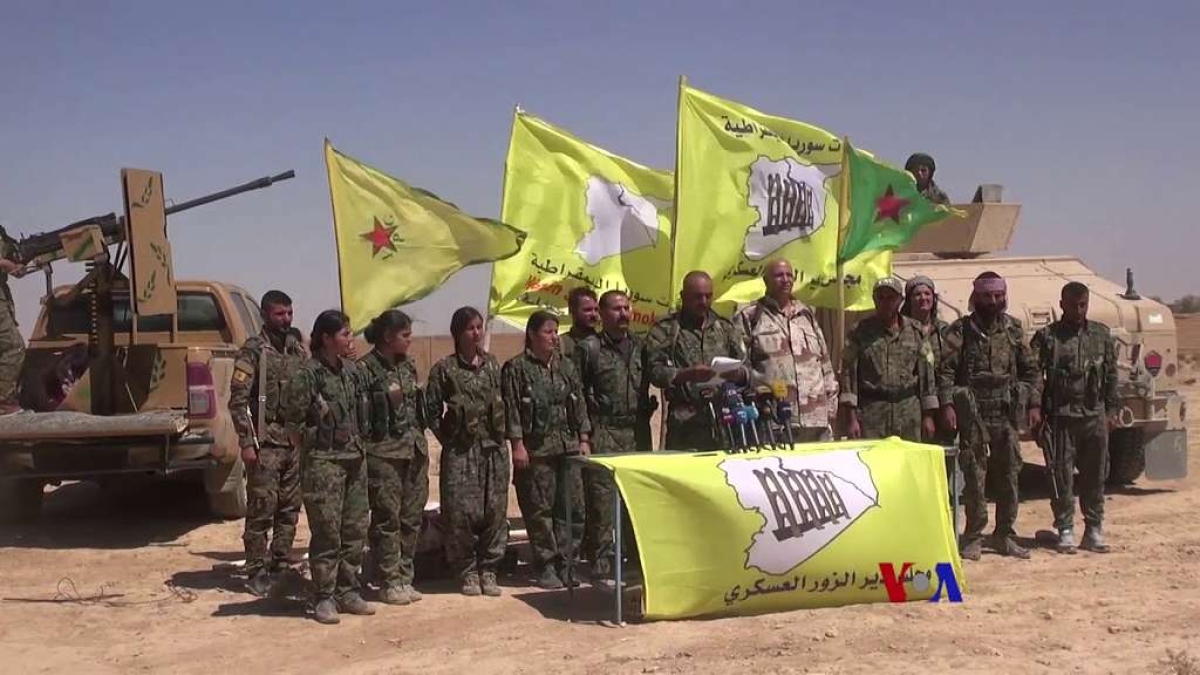Warum es zu neuen Gefechten in Nordostsyrien kommt

Einheiten der SDF in Deir es Zor, Bildquelle: Wikimedia Commons
Weitgehend unbemerkt kam es in den letzten Wochen immer wieder zu gewaltsamen Zusammenstößen zwischen kurdischen Milizen und arabischen Kämpfern in der Region Deir er-Zor. Die ist wichtig für den iranischen Nachschub in den Libanon.
Der Iran transferiert Waffen und Kämpfer über den Irak und Nordostsyrien in den Libanon. Die Grenze bei Deir er-Zor spielt deshalb für Teheran eine zentral wichtige Rolle. Immer wieder bombardieren israelische Kampfflugzeuge diese Nachschubroute und sowohl Iran als auch Assad sind die Einheiten der kurdischen SDF und ihre amerikanischen Unterstützer ein Dorn im Auge. In der Jerusalem Post erklärt Jonathan Spyer worum es bei diesem Konflikt geht:
Syria’s Deir al-Zur province is currently divided into two. The division runs along the line of the Euphrates River, Syria’s main waterway.
East of the river, the area is administered by the US-aligned, Kurdish-dominated Syrian Democratic Forces (SDF). US forces maintain bases in the area, close to the al-Omar oilfield and the Conoco gas field.
West of the river, the Iranian Islamic Revolutionary Guard Corps (IRGC) and its allied militias are in control, in partnership with their allies among the forces of the Bashar Assad regime.
The Iranian-aligned groups won a race against the US-aligned forces down the Euphrates River valley in the summer of 2019.
As a result, the Iranians control the border crossing at al-Bukamal and the surrounding area, and use it for the transport of arms and materiel for their allies in the fronts further west.
Iran wants to drive the US out of Deir al-Zur, and has been seeking to foment an insurgency among the Sunni Arab tribes of the province as part of this effort.
“The main goal of Iran is to come and control this region,” Abu Ali Fullat, an official of the Deir al-Zur military council, told me during a visit to the region in late March. (...)
ONE OF the anomalies of the area east of the Euphrates is that the Assad regime maintains a military presence in two areas east of the Euphrates – in small parts of Hasakeh and Qamishli cities.
These areas have been steadily whittled away over the last 10 years and are surrounded by the SDF.
Following the attacks of August 7, SDF forces surrounded the areas and several regime officers were arrested, according to SDF sources.
On Friday, August 9, against the background of the fighting, a drone was launched at the US-held Kharab al-Jeir base in the oil rich area of Rumeilan, in Hasakeh province. Several regional media sources reported that the drone was launched from Iraq.
Three days after this, the drone strike that killed the Iran-backed militia near al-Bukamal took place.
Given the context of the events of the previous days, it is overwhelmingly likely that the US-led coalition was responsible, and that the counterattack was intended to reinstate deterrence between the US-aligned forces and their Iran-linked opponents.
Will it succeed? The subsequent strike on Conoco, and the evidence of the last seven months suggest not.
But it also seems that the Iranians do not seek currently to turn Deir al-Zur into a major front in the regional confrontation.
The Iranian-associated militias have carried out over 200 attacks on US-led coalition bases in Syria since October 2023.
The greater number of the attacks have not been launched from regime/Iran-controlled Syria to the west of the US/Kurdish area, but rather from its east, from Iraq.
Similarly, Syria has not been used as a site for attacks against Israel, in the way that Lebanon, Iraq, and Yemen have been.
This is in line with the general effort of the Iranian-led axis to keep Syria out of the current round of hostilities, as far as possible.